@floris, you have to adjust the sensitivity of the rain sensor. I splashed some water on the sensor pad and used a small screwdriver to adjust the potentiometer on the interface board until it triggered to my satisfaction. It took a few iterations to get it to trigger at the level I was looking for.
Salmoides
Posts
-
Solar Powered Mini-Weather Station -
21 Sensors from a repurposed Android@AWI, that's OK, our iPhones are so reliable (or should I say "expensive") that we don't get to collect them like Andriods. :grin:
-
Solar Powered Mini-Weather Station@Totche, the original 3v7, 1000mAh lion battery is tucked under the circuit board. You can see the arch of the plastic cover toward the bottom of the picture on the left, just below the DHT22. It is connected to the circuit with the black and red wired connector so it can easily be removed when working with the device.
-
Solar Powered Mini-Weather Station@floris, Yes, those are the pins I used. The BMP085 is also I2C, using the same pins as the lux sensor.
-
Solar Powered Mini-Weather Station@floris, Thank you for your kind words. The luxmeter faces down, so the light is indirectly collected through the diffuser. If I were to build V2.0, I would look into adding a light pipe to provide more direct lighting on the sensor.
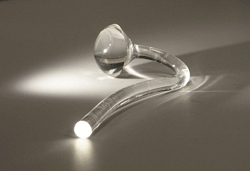
-
Gateway deviceOne thing to keep in mind as you conceptualize this is packaging. For each option you provide (type of radio, style of radio, w/wo Ethernet, etc.) you complicate the design of the enclosure. When we build our own boards, we think of that as we do the layout. When you "hard code" the layout, but add several if-checks in the process, you should remember those of us who don't yet have a fancy 3-D printer. :disappointed: We still need to shoehorn the board into an available box.
-
Power consumption NRF24L01+I've experience close to that before. I've built circuits where the radio continued to draw as much current in sleep mode as when awake. It worked fine, but it wouldn't take a nap. Swapping out the radio solved the problem. That radio is now in a wall wart powered device. I haven't seen one change like that, but I'm sure it's possible.
-
Newb making first sensorBe very careful. You'll get hooked on this stuff like we are and you'll have sensors and controllers all over the place. It never ends. We can't stop ourselves. You will dream up new circuits in your sleep. Ouch, that soldering iron is hot! There's always something being shipped from China. What am I going to do with the other 99 diodes in that little bag? That rosin smells different than the last roll of solder. Gee, I need one of those fancy bench multi-meters. Aww smack, I dropped that screw again! Yes dear, I'll have dinner ready once I finish this sketch. You'll go to bed and then ask yourself if you turned the soldering iron off. Be careful. You've been warned.
-
Humidity/Temp Sensor IssuesWhen you apply voltage to the RAW pin, do you get 5v out of Vcc?
-
Problem powering sensor from external battery (100000mah)i did notice in the AliExpress page for your battery, the illustration has 10,000 mah. The title must be a typo.
-
IR Switch for Luminara Candle Automation (repost with video, photos and final sketch)Happy wife, happy life. Well done.
-
My sensorboard MYS 1.0beta@novicit, Thanks for the guidance. I just ordered some boards myself, and as a novice, your explanation will be very helpful to me as I plan out my sensors.
-
Looking for Case, Battery and PCB for Window Sensor with Tempsens and Battery measurementDamn Capitalists!
-
Relay / Motion MultisensorVery nice.
-
Solar Powered Mini-Weather StationI remember having one of those beginner electronic kits when I was young and I was so excited the day I listened to our local radio station with the crystal radio I built with the kit. Decades later now, I’m finally re-living my childhood with MySensors. It was fun back then and it is again. I’m definitely a noob at this, I’m not an electrical engineer, but I have a knack for adopting the work of others and applying it to my own world. So to start off this project, I first need to thank Hek and all the other more knowledgeable and capable people that have developed what I use. This is really fun.
Many of the MySensor projects are weather related, and this one is no different. I figured if I can do simple sensoring, I’ll learn the basics necessary to move on to the more advanced technologies. I am so new to this that I had to buy a soldering iron and learn how to use it. Research and practice are all part of this, and to that end I’ve already built my Vera Serial Gateway and my first sensor – a battery powered temperature and humidity sensor that sits in my kitchen. This project is my attempt to extend that knowledge to a mini-weather station that operates outdoors.
My requirements were simple: 1) Build an inexpensive outdoor weather station, 2) Use the low-power battery features found in the MySensors Arduino libraries, and 3) Integrate it into my Vera home automation environment. I first put a list together of the components I could put into the weather station to comply with my first requirement. The list goes as follows (I’ve been using eBay, usually in lots of 10):
- Arduino Pro Mini 3.3v 8MHz processor @ $2.50 USD
- NRF24L01+ Transceiver @ $0.90
- DHT22 Humidity & Temperature sensor @ $3.50
- BMP180 Barometric Pressure sensor @ $1.70
- BH1750FVI Ambient Light Intensity sensor @ $2.10
- Rain Sensor Module @ $1.30
The weather station components total $12.00 USD without power and a project box. Humidity was actually the most expensive piece given that the BMP180 also provides temperature. The DHT11 is less costly, but doesn’t really provide the range for an outdoor sensor. I did look at adding some other sensors. For another $10 I could add Ultraviolet sensing, for $25 I could put in a lightning sensor, $45 for wind speed, and even more for wind direction and a rain gauge. All those others would be great to have, but too costly for this project. I might try my hand at building an anemometer to add to this, and I see others are working on rain gauges, but those are projects for another day.
I then needed power and an enclosure. I could have put them in a large waterproof box ($2.70), a three cell AA battery holder ($0.80), and some DuraRabbit batteries for a year ($3.00). For an additional $6.50, I was ready to go. Oh, did I mention I was lazy? I don’t really want to swap out the batteries every six months (or less), so I decided to splurge and go the solar route.
Add a 5v solar panel ($3.35) and a 3.7v 1000mAh li-ion battery ($3.75), and some way to charge the battery (Micro USB 5V 1A 18650 Lithium Battery Charger Board With Protection Module @ $0.75) instead, and my total project cost went to $22.55. Of that, over $10 went to the box, the panel and charger, and the battery. Then I found this.
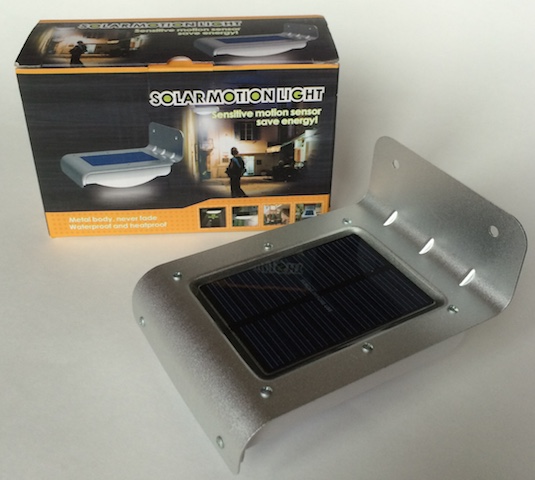
It’s entitled “16 LED Solar Power Motion Sensor Security Lamp Outdoor Waterproof Light” (http://www.ebay.com/itm/271693521438) that you can get for $9.00. I now had a $21 weather station ready to be built.
Taking apart the lamp, I removed the LED panel (worth at least $2.00) and the control board (this has some good stuff on it like a PIR, a light sensor, and the battery charging circuitry, but its use is well beyond my skills), and put them away for another project.
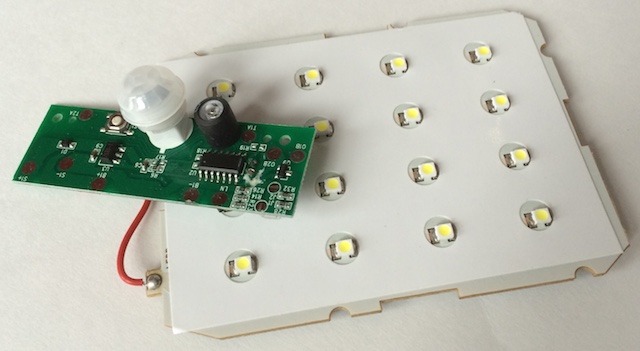
I took a 5x7cm fiberglass PCB and cut a few notches in the sides so the board would fit within the new project case. Using the mounting screws that held the LED board down, I had a good way to affix the circuit board to the case.
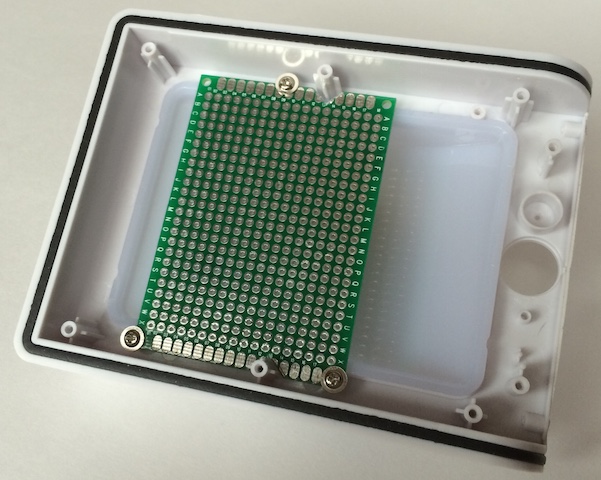
Next, I laid out how to cram all these components (including the R1 at 1MΩ & R2 [a 3296W potentiometer 500kΩ] resistors for the voltage divider to track battery voltage and the capacitor for the radio) into the enclosure. I ended up with a tight fit, but very manageable.
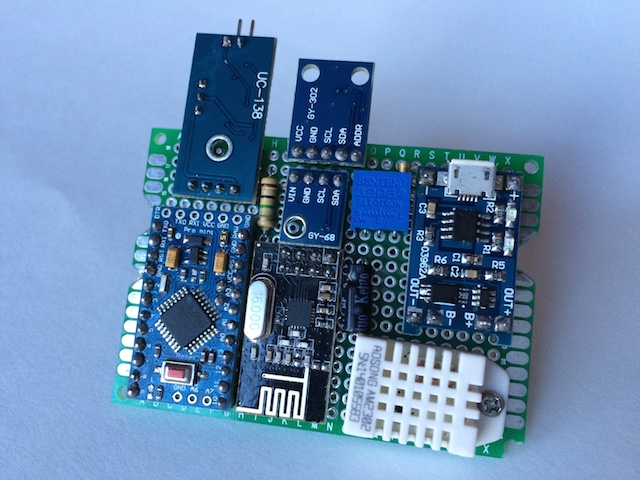
One rule I’ve learned is to always breadboard all the components and measure the performance. This is where I check the current being used during the sleep mode and I get to test my preliminary sketch. It is a very good use of my time as I’ve come upon some bad components in what little of this that I’ve done and this is where they can be identified.
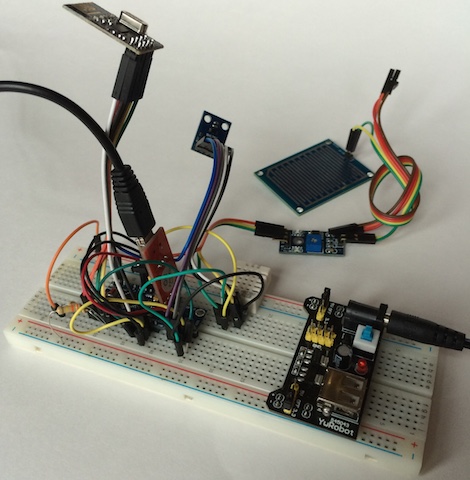
When I started learning the how-to’s of this hobby, I bought all sorts of stuff. One of the first purchases was one of those boxes of 22-gauge wire. The first one was stranded, so then I had to try solid to see if it was any easier to work with. It is, but is still huge compared to what is needed for these low-current projects. I found some old computer cables that had 26-gauge stranded in them. Better, but not what I wanted. Finally I came upon some discussions of wire-wrapping. I now use 30-gauge solid, first installed with a wire-wrapping tool (what a scam and I even found a cheap one for less than $20.)
I decided to add two additional features after breadboarding the circuit. First, I wanted a reset button that could be reached without taking the case apart. At times I’ve found my sensors need a quick reboot. A switch was added to the underside of the PCB and a hole in the underside of the case will allow me to use a paperclip to do a reset.
The other feature I added was a jumper that I could use to enable or disable the rain sensor if I chose to at a later date. For some reason it adds a significant load to the circuit. Without the rain sensor enabled, the circuit idles at 270 µA. With it I get 0.98 mA during the gw.sleep command. If I was smart enough, I’m sure I could get that down, but that’s still something to be learned. The underside, as usual, looked like spaghetti.
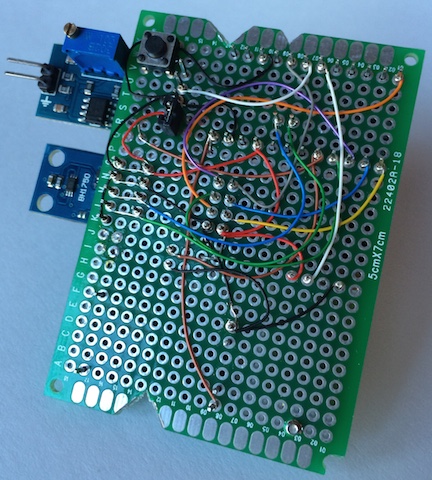
After a little bit of solder (I’m actually getting pretty good at that part), I have a fully functional circuit. Since the Li-Ion charging component takes a micro-USB connection, I charged the battery fully and then adjusted the pot to get the AO output to be right at 1023. For this setup my voltmeter showed the battery at 4.15v. I then needed to calibrate the circuit to get to the lower end of the acceptable voltage range. I’ve seen several different numbers for the bottom end of a 3.7v li-ion battery, some down to 2.7v. I chose 3.3v as my lowest acceptable value and proceeded to drain the battery (those LED arrays came in handy after all) down to 3.0v to see what the circuit value came out to be. For my setup, at 3.3v I was getting a value of 800 from pin A0. I updated the sketch so that it would be equal to 0% (hopefully it never gets there.)
I had one addition to make to the project case. The rain sensor has a board that needs to be exposed to the elements. I drilled a couple of holes in the front end of the case and found some connectors that would work. The hole in the original case for the PIR sensor was a great opening to pass the cable through. The results actually look pretty good, if I can say so myself.
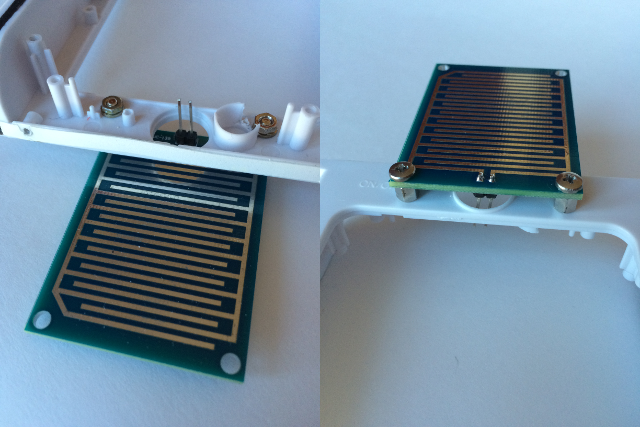
A couple of last minute touch-ups: two holes in the lens of the light, one for the reset button and one for the pot that adjusts the sensitivity of the rain sensor. I also take off any LEDs on the circuit, even LED13 on the Arduino. Every little bit helps. Does an LED actually illuminate if no one is there to see it? The final product came out nice.
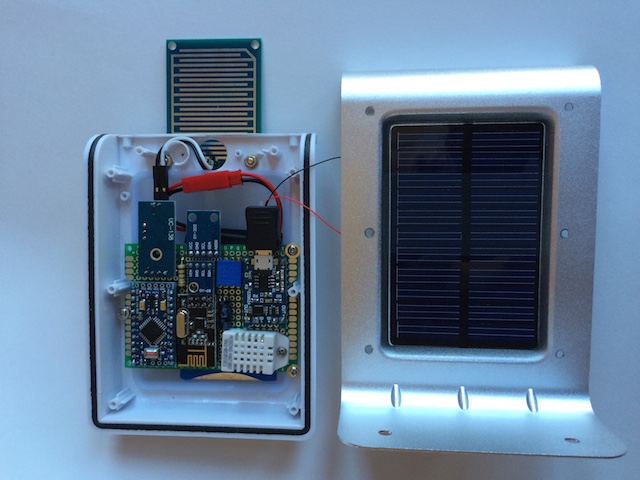
One last upload of the final sketch. I took all the weather prediction logic out of the pressure sketch to save room for the other components. The SLEEP_TIME parameter is set for once every minute. I also added some lines of code to have the sensor update all measurements once an hour. I really like the ability to see when a measurement was last updated. That’s a nice touch to the MySensors library.
#include <SPI.h> #include <MySensor.h> #include <DHT.h> #include <BH1750.h> #include <Wire.h> #include <Adafruit_BMP085.h> #define CHILD_ID_HUM 0 #define CHILD_ID_TEMP 1 #define CHILD_ID_LIGHT 2 #define CHILD_ID_BARO 3 #define CHILD_ID_BTEMP 4 #define CHILD_ID_RAIN 5 #define DIGITAL_INPUT_RAIN_SENSOR 3 #define HUMIDITY_SENSOR_DIGITAL_PIN 4 #define INTERRUPT DIGITAL_INPUT_RAIN_SENSOR-2 boolean metric = false; int altitude = 221; // 741 feet above sealevel float lastBmpTemp = -1; float lastPressure = -1; float lastHum = -1; float lastTemp = -1; int BATTERY_SENSE_PIN = A0; int lastRainValue = -1; int lastBatteryPcnt = 0; int updateAll = 60; int updateCount = 0; uint16_t lastLux; unsigned long SLEEP_TIME = 60000; int batteryBasement = 800; float batteryConstant = 100.0 / (1023 - batteryBasement); Adafruit_BMP085 bmp = Adafruit_BMP085(); BH1750 lightSensor; DHT dht; MySensor gw; MyMessage msgHum(CHILD_ID_HUM, V_HUM); MyMessage msgTemp(CHILD_ID_TEMP, V_TEMP); MyMessage msgLux(CHILD_ID_LIGHT, V_LIGHT_LEVEL); MyMessage msgBtemp(CHILD_ID_BTEMP, V_TEMP); MyMessage msgPressure(CHILD_ID_BARO, V_PRESSURE); MyMessage msgRain(CHILD_ID_RAIN, V_TRIPPED); void setup() { analogReference(INTERNAL); gw.begin(); dht.setup(HUMIDITY_SENSOR_DIGITAL_PIN); bmp.begin(); gw.sendSketchInfo("Weather Sensor", "1.0"); gw.present(CHILD_ID_HUM, S_HUM); gw.present(CHILD_ID_TEMP, S_TEMP); gw.present(CHILD_ID_LIGHT, S_LIGHT_LEVEL); gw.present(CHILD_ID_BARO, S_BARO); gw.present(CHILD_ID_BTEMP, S_TEMP); gw.present(CHILD_ID_RAIN, S_MOTION); pinMode(DIGITAL_INPUT_RAIN_SENSOR, INPUT); lightSensor.begin(); metric = gw.getConfig().isMetric; } void loop() { updateCount += 1; if (updateCount == updateAll) { lastTemp = -1; lastHum = -1; lastLux = -1; lastBmpTemp = -1; lastPressure = -1; lastRainValue = -1; lastBatteryPcnt = -1; updateCount = 0; } delay(dht.getMinimumSamplingPeriod()); float temperature = dht.getTemperature(); if (isnan(temperature)) { lastTemp = -1; } else if (temperature != lastTemp) { lastTemp = temperature; if (!metric) { temperature = temperature * 1.8 + 32.0; } gw.send(msgTemp.set(temperature, 1)); } float humidity = dht.getHumidity(); if (isnan(humidity)) { lastHum = -1; } else if (humidity != lastHum) { lastHum = humidity; gw.send(msgHum.set(humidity, 1)); } uint16_t lux = lightSensor.readLightLevel(); if (lux != lastLux) { gw.send(msgLux.set(lux)); lastLux = lux; } float pressure = bmp.readSealevelPressure(altitude) * 0.01; float bmptemp = bmp.readTemperature(); if (!metric) { bmptemp = bmptemp * 1.8 + 32.0; } if (bmptemp != lastBmpTemp) { gw.send(msgBtemp.set(bmptemp,1)); lastBmpTemp = bmptemp; } if (pressure != lastPressure) { gw.send(msgPressure.set(pressure, 0)); lastPressure = pressure; } int rainValue = digitalRead(DIGITAL_INPUT_RAIN_SENSOR); if (rainValue != lastRainValue) { gw.send(msgRain.set(rainValue==0?1:0)); lastRainValue = rainValue; } int sensorValue = analogRead(BATTERY_SENSE_PIN); int batteryPcnt = (sensorValue - batteryBasement) * batteryConstant; if (lastBatteryPcnt != batteryPcnt) { gw.sendBatteryLevel(batteryPcnt); lastBatteryPcnt = batteryPcnt; } gw.sleep(SLEEP_TIME); }Then a test to make sure it’s dumping out its results as it should
sensor started, id 1 send: 1-1-0-0 s=255,c=0,t=17,pt=0,l=5,st=ok:1.4.1 send: 1-1-0-0 s=255,c=3,t=6,pt=1,l=1,st=ok:0 read: 0-0-1 s=255,c=3,t=6,pt=0,l=1:I send: 1-1-0-0 s=255,c=3,t=11,pt=0,l=14,st=ok:Weather Sensor send: 1-1-0-0 s=255,c=3,t=12,pt=0,l=3,st=ok:1.0 send: 1-1-0-0 s=0,c=0,t=7,pt=0,l=5,st=ok:1.4.1 send: 1-1-0-0 s=1,c=0,t=6,pt=0,l=5,st=ok:1.4.1 send: 1-1-0-0 s=2,c=0,t=16,pt=0,l=5,st=ok:1.4.1 send: 1-1-0-0 s=3,c=0,t=8,pt=0,l=5,st=ok:1.4.1 send: 1-1-0-0 s=4,c=0,t=6,pt=0,l=5,st=ok:1.4.1 send: 1-1-0-0 s=5,c=0,t=1,pt=0,l=5,st=ok:1.4.1 send: 1-1-0-0 s=1,c=1,t=0,pt=7,l=5,st=ok:80.8 send: 1-1-0-0 s=0,c=1,t=1,pt=7,l=5,st=ok:28.2 send: 1-1-0-0 s=2,c=1,t=23,pt=3,l=2,st=ok:83 send: 1-1-0-0 s=4,c=1,t=0,pt=7,l=5,st=ok:80.6 send: 1-1-0-0 s=3,c=1,t=4,pt=7,l=5,st=ok:1020 send: 1-1-0-0 s=5,c=1,t=16,pt=2,l=2,st=ok:0 send: 1-1-0-0 s=255,c=3,t=0,pt=1,l=1,st=ok:91Finally, we then go to Vera and make sure she’s happy.
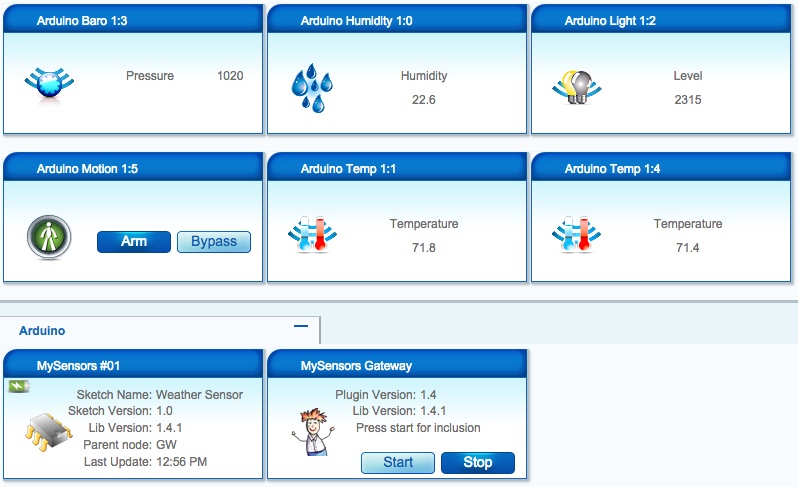
This has been a great learning experience for me as it’s my first documented project. I made a bunch of mistakes in between most of the steps you see here. I’ve practiced my soldering techniques for many, many hours. One battery went bye-bye when I didn’t notice the leads had crossed. The smoke was a real good indicator that I’d messed up. I’ve ruined my fair share of components, but I chalk it all up to experience and don’t dwell on them. This hobby is a lot less expensive than golf or fishing, even with my mistakes. I look forward to bigger and better as I continue learn. Thanks again, Hek. This is a hobby that I truly enjoy.
